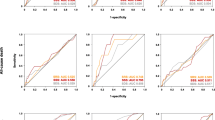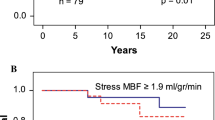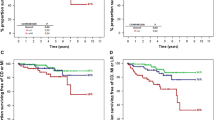Abstract
Background
We evaluated the prognostic value of exercise201Tl indexes of myocardial hypoperfusion in patients with suspected or known coronary artery disease.
Methods and Results
Patients were divided into two groups: group I consisted of 332 patients with diagnostic electrocardiographic stress test results and group II consisted of 144 patients with nondiagnostic (inadequate or uninterpretable) stress electrocardiograms. At the 2-year follow-up, 20 hard events (16 cardiac deaths and 4 nonfatal myocardial infarctions) and 80 soft events (coronary revascularization procedures) occurred in group I. Considering total events, thallium imaging provided significant prognostic information in addition to clinical and exercise stress test data in the total study population (p<0.001) and in patients with previous myocardial infarction (p<0.001); in patients without previous infarction, thallium imaging added incremental prognostic value only in those with positive electrocardiographic stress test results (p<0.01). When only hard events were considered, thallium variables added further information only in patients with previous myocardial infarction (p<0.05). In group II at the end of follow-up, 15 hard and 39 soft events had occurred. In these patients occurrence of total (p<0.001), hard (p<0.05), and soft (p<0.001) events was higher in those with abnormal thallium scintigraphic results than in those without. Moreover, no clinical and exercise variable, except history of myocardial infarction, was significantly related to outcome, whereas both indexes of extent and severity of hypoperfusion were significant.
Conclusions
The results of this study demonstrate that scintigraphic indexes of myocardial hypoperfusion obtained by qualitative planar thallium imaging give unique prognostic information in patients with nondiagnostic electrocardiographic stress test results. Thallium imaging provides incremental prognostic information even in patients with diagnostic electrocardiographic stress test results but not in the low-risk subset of patients without previous infarction who have negative electrocardiographic stress test results.
Similar content being viewed by others
References
Beller GA. Diagnostic accuracy of thallium-201 myocardial perfusion imaging. Circulation 1991;84(suppl):I1–6.
Okada RD, Boucher CA, Strauss HW, Pohost GM. Exercise radionuclide imaging approaches to coronary artery disease. Am J Cardiol 1980;46:1188–209.
Rigo P, Bailey IK, Griffith LSC, Pitt B, Wagner HN, Becker LC. Stress thallium-201 myocardial scintigraphy for the detection of individual coronary arterial lesions in patients with and without previous myocardial infarction. Am J Cardiol 1981;48:209–16.
Pollock SG, Watson DD, Finkelstein DM, Gibson RS, Beller GA, Kaul S. A simplified approach to evaluating multiple test outcomes and multiple disease states in relation to the exercise thallium-201 stress test in suspected coronary artery disease. Am J Cardiol 1989;64:466–70.
McCarthy DM, Sciacca RR, Blood DK, Cannon P. Discriminant function analysis using thallium-201 scintiscans and exercise stress test variables to predict the presence and extent of coronary artery disease. Am J Cardiol 1982;49:1917–26.
Kotler TS, Diamond GA. Exercise thallium-201 scintigraphy in the diagnosis and prognosis of coronary artery disease. Ann Intern Med 1990;113:684–702.
McCarthy DM, Blood DK, Sciacca RR, Cannon PJ. Single dose myocardial perfusion imaging with thallium-201: application in patients with nondiagnostic electrocardiographic stress tests. Am J Cardiol 1979;43:899–906.
Iskandrian AS, Wasserman LA, Anderson GS, Hakki H, Segal BL, Kane S. Merits of stress thallium-201 myocardial perfusion imaging in patients with inconclusive exercise electrocardiograms: correlation with coronary arteriograms. Am J Cardiol 1980;46:553–8.
Iskandrian AS, Segal BL. Value of exercise thallium-201 imaging in patients with diagnostic and nondiagnostic exercise electrocardiograms. Am J Cardiol 1981;48:233–8.
Brown KA, Boucher CA, Okada RD, et al. Prognostic value of exercise thallium-201 imaging in patients presenting for evaluation of chest pain. J Am Coll Cardiol 1983;1:994–1001.
Iskandrian AS, Hakki AH, Kane-Marsch S. Prognostic implications of exercise thallium-201 scintigraphy in patients with suspected or known coronary artery disease. Am Heart J 1985;110:135–43.
Wackers FJT, Russo DJ, Russo D, Clements JP. Prognostic significance of normal quantitative planar thallium-201 stress scintigraphy in patients with chest pain. J Am Coll Cardiol 1985;6:27–30.
Iskandrian AS, Hakki AH, Kane-Marsch S. Exercise thallium-201 scintigraphy in men with nondiagnostic exercise electrocardiograms: prognostic implications. Arch Intern Med 1986;146:2189–93.
Koss JH, Kobren SM, Grunwald AM, Bodenheimer MM. Role of exercise thallium-201 myocardial perfusion scintigraphy in predicting prognosis in suspected coronary artery disease. Am J Cardiol 1987;59:531–4.
Ladenheim ML, Pollock BH, Rozanski A, et al. Extent and severity of myocardial hypoperfusion as predictors of prognosis in patients with suspected coronary artery disease. J Am Coll Cardiol 1986;7:464–71.
Ladenheim ML, Kotler TS, Pollock BH, Berman DS, Diamond GA. Incremental prognostic power of clinical history, exercise electrocardiography and myocardial perfusion scintigraphy in suspected coronary artery disease. Am J Cardiol 1987;59:270–7.
Pollock SG, Abbott RD, Boucher CA, Beller GA, Kaul S. Independent and incremental prognostic value of tests performed in hierarchical order to evaluate patients with suspected coronary artery disease: validation of models based on these tests. Circulation 1992;85:237–48.
Kaul S, Lilly DR, Gascho JA, et al. Prognostic utility of the exercise thallium-201 test in ambulatory patients with chest pain: comparison with cardiac catheterization. Circulation 1988;77:745–58.
Kaul S, Finkelstein DM, Homma S, Leavitt M, Okada RD, Boucher CA. Superiority of quantitative exercise thallium-201 variables in determining long-term prognosis in ambulatory patients with chest pain: a comparison with cardiac catheterization. J Am Coll Cardiol 1988;12:25–34.
Petretta M, Bonaduce D, Cuocolo A, et al. Incremental prognostic value of thallium imaging and coronary angiography in patients with a symptom-limited ECG stress test. Coronary Artery Dis 1993;4:637–44.
Cuocolo A, Pace L, Chiariello M, Trimarco B, Salvatore M. Identification of viable myocardium in patients with chronic coronary artery disease: comparison of thallium-201 scintigraphy with reinjection and technetium-99-m-methoxyisobutyl-isonitrile. J Nucl Med 1992;33:505–11.
Rocco TP, Dilsizian V, McKusick KA, Fischman AJ, Boucher CA, Strauss HW. Comparison of thallium redistribution with rest reinjection imaging for the detection of viable myocardium. Am J Cardiol 1990;66:158–63.
Bairey CN, Rozanski A, Maddahi J, Resser KJ, Berman DS. Exercise thallium-201 scintigraphy and prognosis in typical angina pectoris and negative exercise electrocardiography. Am J Cardiol 1989;64:282–7.
Weiss AT, Berman DS, Lew AS, et al. Transient ischemic dilation of the left ventricle on stress thallium scintigraphy: a marker of severe and extensive coronary artery disease. J Am Coll Cardiol 1987;9:752–9.
Nygaard TW, Gibson RS, Ryan JM, Gasho JA, Watson DD, Beller GA. Prevalence of high-risk thallium-201 scintigraphic findings in left main coronary artery stenosis: comparison with patients with multi- and single-vessel coronary artery disease. Am J Cardiol 1984;53:462–9.
Kahn HA, Sempos CT. Adjustment using multiple linear regression and multiple logistic functions. In: Statistical methods in epidemiology. New York: Oxford University Press, 1989:137–67.
Mood AM, Graybill FA. Introduction to the theory of statistics. New York: McGraw-Hill, 1963.
Fagan LF Jr, Shaw L, Kong BA, Caralis DG, Wiens RD, Chaitman BR. Prognostic value of exercise thallium scintigraphy in patients with good exercise tolerance and a normal or abnormal exercise electrocardiogram and suspected or confirmed coronary artery disease. Am J Cardiol 1992;69:607–11.
Gill JB, Ruddy TD, Newell JB, Finkelstein DM, Strauss HW, Boucher CA. Prognostic importance of thallium uptake by the lungs during exercise in coronary artery disease. N Engl J Med 1987;317:1485–9.
Gibson RS, Watson DD, Craddock GB, et al. Prediction of cardiac events after uncomplicated myocardial infarction: a prospective study comparing predischarge exercise thallium-201 scintigraphy and coronary angiography. Circulation 1983;68:321–36.
Abraham RD, Freedman SB, Dunn RF, et al. Prediction of multivessel coronary artery disease and prognosis early after acute myocardial infarction by exercise electrocardiography and thallium-201 myocardial perfusion scanning. Am J Cardiol 1986;58:423–7.
Wilson WW, Gibson RS, Nygaard TW, et al. Acute myocardial infarction associated with single vessel coronary artery disease: an analysis of clinical outcome and the prognostic importance of vessel patency and residual ischemic myocardium. J Am Coll Cardiol 1988;11:223–34.
Coronary Drug Project Research Group. Clofibrate and niacin in coronary heart disease. J Am Med Assoc 1975;231:360–81.
Lipid Research Clinics Program. The Lipid Research Clinics Coronary Primary Prevention Trial Results, I: reduction in incidence of coronary heart disease. JAMA 1984;251:351–64.
Multicenter Diltiazem Postinfarction Trial Research Group. The effect of diltiazem on mortality and reinfarction after myocardial infarction. N Engl J Med 1988;319:385–92.
Oosterhuis WP, Niemeyer MG, Kuijper AFM, et al. Evaluation of the incremental diagnostic value and impact on patient treatment of thallium scintigraphy. J Nucl Med 1992;33:1727–34.
Fleiss JL, Bigger JT Jr, McDermott M, et al. Nonfatal myocardial infarction is, by itself, an inappropriate end point in clinical trials in cardiology. Circulation 1990;81:684–5.
Christian TF, Miller TD, Bailey KR, Gibbons RJ. Noninvasive identification of severe coronary artery disease using exercise tomographic thallium-201 imaging. Am J Cardiol 1992;70:14–20.
Iskandrian AS, Chae SC, Heo J, Stanberry CD, Wasserleben V, Cave V. Independent and incremental prognostic value of exercise single-photon emission computed tomographic (SPECT) thallium imaging in coronary artery disease. J Am Coll Cardiol 1993;22:665–70.
Steinberg EH, Koss JH, Lee M, Grunwald AM, Bodenheimer MM. Prognostic significance from 10-year follow-up of a qualitatively normal planar exercise thallium test in suspected coronary artery disease. Am J Cardiol 1993;71:1270–3.
Author information
Authors and Affiliations
Rights and permissions
About this article
Cite this article
Petretta, M., Cuocolo, A., Carpinelli, A. et al. Prognostic value of myocardial hypoperfusion indexes in patients with suspected or known coronary artery disease. J Nucl Cardiol 1, 325–337 (1994). https://doi.org/10.1007/BF02939954
Received:
Accepted:
Issue Date:
DOI: https://doi.org/10.1007/BF02939954




